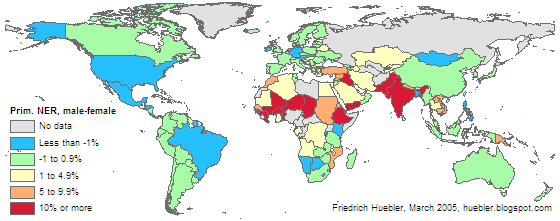Gender disparity in primary school: male-female net enrollment ratio, 2001/2002

Data source: UNESCO Institute for Statistics (UIS). 2004. Global Education Digest 2004. Montreal: UIS.
Girls continue to be disadvantaged in many countries of Africa, the Middle East, South Asia, and East Asia. In three countries, the NER of girls was more than 20 percentage points below that of boys: Benin (26% difference in NER), Yemen (24%), and Chad (23%). In 14 more countries, the gender disparity in primary school enrollment was between 10 and 20 percentage points: Pakistan (20%), Cote d'Ivoire (19%), Liberia (18%), Togo (16%); Guinea, Guinea-Bissau, and India (15%); Iraq and Equatorial Guinea (14%); Niger (13%); Mali and Burkina Faso (12%); Burundi and Ethiopia (11%). In 20 countries, the gender disparity was between 5 and 10 percentage points, and in 33 countries it was between 1 and 5 percentage points.
While gender disparity in primary school is mostly to the disadvantage of girls, there are also countries where boys are less likely to be enrolled. In four countries, the NER of girls was 5 ore more percentage points above that of boys: Saint Kitts and Nevis (9% difference in NER), Lesotho (6%); Namibia and Netherlands Antilles (5%). Another 19 countries had female-male disparities between 1 and 5 percentage points.
Related articles
Friedrich Huebler, 20 March 2005 (edited 12 October 2008), Creative Commons License
Permanent URL: http://huebler.blogspot.com/2005/03/gender-disparity-in-primary-school.html
No comments:
Post a Comment